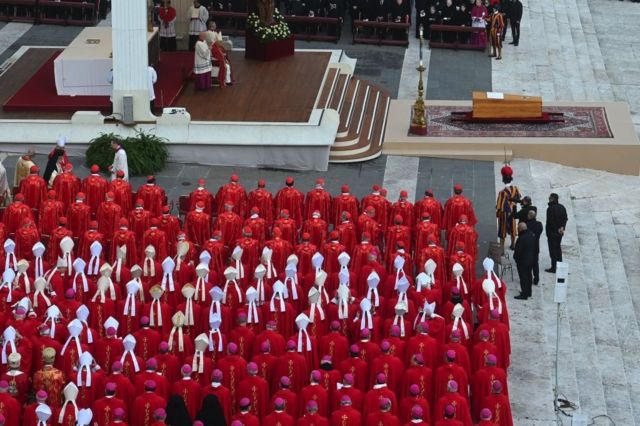
-
Published: 05 January 2023

Tens of thousands of people flocked this morning to St. Peter's Square in the Vatican to attend the funeral ceremony of Pope Emeritus Benedict XVI, and their number was estimated at about 50 thousand, compared to 3 million who participated in the funeral of John Paul II.
Tens of thousands of worshipers clapped goodbye to the coffin of the honorary Pope Benedict XVI, who is buried with a private ceremony in the Crypt of St. Peter's Basilica in the Vatican, after a public state funeral.
This funeral constitutes a rare precedent, which the Catholic Church has not known in its modern history, as no pope has ever led a funeral prayer for his predecessor
The funeral ceremony in St. Peter's Square in the Vatican began at half past nine in the morning, local time of Italy. Traditionally, the funeral mass of the pope is presided over by the dean of the College of Cardinals, and his chair remains vacant until the election of a new pope.
This time, the head of the Catholic Church, Francis, prayed for Pope Emeritus Benedict, who stepped down in 2013.
The church witnessed a similar event in 1802, when Pope Pius VII presided over the funeral of Pius VI, who died in exile in France in 1799, but had not stepped down.
The Holy See officially invited to the funeral only two missions, German and Italian. Italy, which hosts the Vatican on its territory, and Germany, the homeland of Cardinal Joseph Ratzinger, the dean of the Congregation for the doctrine of the faith, who became the head of the church and bore the name of Benedict XVI from 2005 until he stepped down in 2013.
Before the ceremony began, worshipers, including a large number of priests and nuns, stood in line to cross the security gates and enter the square. Some carried the flags of Germany and the province of Bavaria, from which the late Pope hails, as well as the flag of Argentina, the country of the current pope. German worshippers carried a banner with the inscription "Thank you Benedict".
Unlike usual, the bells of St. Peter's Basilica did not ring with sadness when the death of Benedict XVI was announced, according to the Vatican website, which happens only when the pope dies, who is still in office.
Also, there was no need to break the pope's ring when he died, since Benedict's ring had already been broken when he stepped down.
The media office of the Holy See published details of the funeral prayer, and Vatican Media spokesman Matteo Bruni said that some excerpts related to the prayer for the Popes had been removed, and paragraphs appropriate to the pope's honorary position had been added.
According to Bruni, the pope will be buried along with a number of his personal items, including his priestly scarf, which is made of wool, symbolizing the position of patron. Some coins and medals minted during his pontificate will also be buried with him, along with a text summarizing the main stations of his sitting on the Holy See, wrapped in a metal cylinder.
Those who follow the history of the church say that Benedict's abdication and his decision to spend his last years in the Vatican as Pope Emeritus created an unprecedented equation in the church, as two men wearing the pontiff's white uniform entered the Catholic home.
According to the official Vatican website, the late pope recommended that his funeral be simple. He also asked to be buried on the site where John Paul II was buried, in the Crypt of St. Peter's Cathedral. That tomb has been vacant since 2011, when John Paul II was beatified and his body was moved to a higher level in the church, to be displayed in front of worshipers wishing to visit him.
Most of the former popes were buried in the catacombs of the cathedral itself, except for those who were recommended to be buried in other churches.
As usual, the pope's body will be buried in three coffins. An inner Cypress coffin wrapped in red ribbons, a coffin in the center in zinc, and a third coffin in Walnut, which is locked by gold screws.
According to the Washington Post, the origins of this tradition are not precisely understood, even for specialists, but some historians are likely that the three coffins had practical purposes, including protecting the body of the pope from decomposition and preserving it for later display in the event of his beatification as a saint, as well as to protect it from theft during periods of political turmoil.
